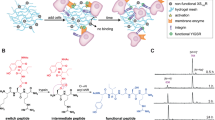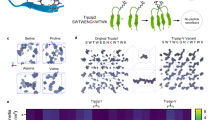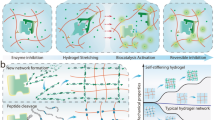Abstract
Controlling molecular interactions between bioinspired molecules can enable the development of new materials with higher complexity and innovative properties. Here we report on a dynamic system that emerges from the conformational modification of an elastin-like protein by peptide amphiphiles and with the capacity to access, and be maintained in, non-equilibrium for substantial periods of time. The system enables the formation of a robust membrane that displays controlled assembly and disassembly capabilities, adhesion and sealing to surfaces, self-healing and the capability to undergo morphogenesis into tubular structures with high spatiotemporal control. We use advanced microscopy along with turbidity and spectroscopic measurements to investigate the mechanism of assembly and its relation to the distinctive membrane architecture and the resulting dynamic properties. Using cell-culture experiments with endothelial and adipose-derived stem cells, we demonstrate the potential of this system to generate complex bioactive scaffolds for applications such as tissue engineering.
This is a preview of subscription content, access via your institution
Access options
Subscribe to this journal
Receive 12 print issues and online access
$259.00 per year
only $21.58 per issue
Buy this article
- Purchase on Springer Link
- Instant access to full article PDF
Prices may be subject to local taxes which are calculated during checkout




Similar content being viewed by others
References
Sasai, Y. Cytosystems dynamics in self-organization of tissue architecture. Nature 493, 318–326 (2013).
Whitesides, G. M. & Grzybowski, B. Self-assembly at all scales. Science 295, 2418–2421 (2002).
Silva, N. C. S. et al. Protein-based materials: from sources to innovative sustainable materials for biomedical applications. J. Mater. Chem. B 2, 3715–3740 (2014).
Urry, D. W. et al. in Biotechnological Polymers: Medical, Pharmaceutical and Industrial Applications (ed. Gebelein, C. G.) 82–103 (Technomic, 1993).
Smits, F. C., Buddingh, B. C., van Eldijk, M. B. & van Hest, J. C. Elastin-like polypeptide based nanoparticles: design rationale toward nanomedicine. Macromol. Biosci. 15, 36–51 (2015).
Almine, J. F. et al. Elastin-based materials. Chem. Soc. Rev. 39, 3371–3379 (2010).
Martin, L., Castro, E., Ribeiro, A., Alonso, M. & Rodriguez-Cabello, J. C. Temperature-triggered self-assembly of elastin-like block co-recombinamers: the controlled formation of micelles and vesicles in an aqueous medium. Biomacromolecules 13, 293–298 (2012).
Rodriguez-Cabello, J. C., Prieto, S., Reguera, J., Arias, F. J. & Ribeiro, A. Biofunctional design of elastin-like polymers for advanced applications in nanobiotechnology. J. Biomater. Sci. Polym. Ed. 18, 269–286 (2007).
Fletcher, J. M. et al. Self-assembling cages from coiled-coil peptide modules. Science 340, 595–599 (2013).
Tang, T.-Y. et al. Fatty acid membrane assembly on coacervate microdroplets as a step towards a hybrid protocell model. Nature Chem. 6, 527–533 (2014).
Hartgerink, J. D., Beniash, E. & Stupp, S. I. Self-assembly and mineralization of peptide-amphiphile nanofibers. Science 294, 1684–1688 (2001).
Zhang, S. et al. A self-assembly pathway to aligned monodomain gels. Nature Mater. 9, 594–601 (2010).
Glaab, F., Kellermeier, M., Kunz, W., Morallon, E. & Garcia-Ruiz, J. M. Formation and evolution of chemical gradients and potential differences across self-assembling inorganic membranes. Angew. Chem. Int. Ed. 51, 4317–4321 (2012).
Ritchie, C. et al. Spontaneous assembly and real-time growth of micrometre-scale tubular structures from polyoxometalate-based inorganic solids. Nature Chem. 1, 47–52 (2009).
Noorduin, W. L., Grinthal, A., Mahadevan, L. & Aizenberg, J. Rationally designed complex, hierarchical microarchitectures. Science 340, 832–837 (2013).
Galland, R. et al. Fabrication of three-dimensional electrical connections by means of directed actin self-organization. Nature Mater. 12, 416–421 (2013).
Adler-Abramovich, L. et al. Self-assembled arrays of peptide nanotubes by vapour deposition. Nature Nanotech. 4, 849–854 (2009).
Capito, R. M., Azevedo, H. S., Velichko, Y. S., Mata, A. & Stupp, S. I. Self-assembly of large and small molecules into hierarchically ordered sacs and membranes. Science 319, 1812–1816 (2008).
Ferreira, D. S., Marques, A. P., Reis, R. L. & Azevedo, H. S. Hyaluronan and self-assembling peptides as building blocks to reconstruct the extracellular environment in skin tissue. Biomater. Sci. 1, 952–964 (2013).
Carvajal, D. et al. Physical properties of hierarchically ordered self-assembled planar and spherical membranes. Soft Matter 6, 1816–1823 (2010).
Chow, L. W. et al. A bioactive self-assembled membrane to promote angiogenesis. Biomaterials 32, 1574–1582 (2011).
Velichko, Y. S. et al. Electric field controlled self-assembly of hierarchically ordered membranes. Adv. Funct. Mater. 22, 369–377 (2012).
Carew, D. B., Channon, K. J., Manners, I. & Woolfson, D. N. Polyelectrolite-surfactant nanocomposite membranes formed at liquid-liquid interface. Soft Matter 7, 3475–3481 (2011).
Urry, D. W. Physical chemistry of biological free energy transduction as demonstrated by elastin protein-based polymers. J. Phys. Chem. B 101, 11007–11028 (1997).
Miller, R. et al. Dynamics of protein and mixed protein/surfactant adsorption layers at the water/fluid interface. Adv. Colloid Interface Sci. 86, 39–82 (2000).
Kotsmar, Cs et al. Thermodynamics, adsorption kinetics and rheology of mixed protein–surfactant interfacial layers. Adv. Colloid Interface Sci. 150, 41–54 (2009).
Bitton, R. et al. Electrostatic control of structure in self-assembled membranes. Small 10, 500–505 (2014).
Boekhoven, J. et al. Alginate–peptide amphiphile core–shell microparticles as a targeted drug delivery system. RSC Adv. 5, 8753–8756 (2015).
Mertens, H. D. & Svergun, D. I. Structural characterization of proteins and complexes using small-angle X-ray solution scattering. J. Struct. Biol. 172, 128–141 (2010).
Giehm, L., Oliveira, C. L., Christiansen, G., Pedersen, J. S. & Otzen, D. E. SDS-induced fibrillation of alpha-synuclein: an alternative fibrillation pathway. J. Mol. Biol. 401, 115–133 (2010).
Andersen, K. K. et al. The role of decorated SDS micelles in sub-CMC protein denaturation and association. J. Mol. Biol. 391, 207–226 (2009).
Mann, S. Self-assembly and transformation of hybrid nano-objects and nanostructures under equilibrium and non-equilibrium conditions. Nature Mater. 8, 781–792 (2009).
Meinhardt, H. & Gierer, A. Pattern formation by local self-activation and lateral inhibition. Bioessays 22, 753–760 (2000).
Kawska, A. et al. How actin network dynamics control the onset of actin-based motility. Proc. Natl Acad. Sci. USA 109, 14440–14445 (2012).
Siton, O. et al. Cortactin releases the brakes in actin-based motility by enhancing WASP-VCA detachment from Arp2/3 branches. Curr. Biol. 21, 2092–2097 (2011).
Bernheim-Groswasser, A., Wiesner, S., Golsteyn, R. M., Carlier, M. F. & Sykes, C. The dynamics of actin-based motility depend on surface parameters. Nature 417, 308–311 (2002).
Hirst, A. R. et al. Biocatalytic induction of supramolecular order. Nature Chem. 2, 1089–1094 (2010).
Carnall, J. M. et al. Mechanosensitive self-replication driven by self-organization. Science 327, 1502–1506 (2010).
Boccafoschi, F. et al. Human elastin polypeptides improve the biomechanical properties of three-dimensional matrices through the regulation of elastogenesis. J. Biomed. Mater. Res. A 103, 1218–1230 (2015).
Choi, S. K., Park, J. K., Lee, K. M., Lee, S. K. & Jeon, W. B. Improved neural progenitor cell proliferation and differentiation on poly(lactide-co-glycolide) scaffolds coated with elastin-like polypeptide. J. Biomed. Mater. Res. B 101, 1329–1339 (2013).
McClendon, M. T. & Stupp, S. I. Tubular hydrogels of circumferentially aligned nanofibers to encapsulate and orient vascular cells. Biomaterials 33, 5713–5722 (2012).
Acknowledgements
The work was supported by the European Research Council Starting Grant (STROFUNSCAFF), the European Commission under FP7 and H2020 programs ((NMP3-LA-2011-263363, HEALTH-F4-2011-278557, PITN-GA-2012-317304, MSCA-ITN-2014-ETN- 642687, 642687 H2020-NMP-2014-646075), the Ministry of Economy and Competitiveness (Spain) (MAT2012-38043-C02-01, MAT2013-41723-R, MAT2013-42473-R) the Junta de Castilla y Leon (VA244U13, VA313U14) and the Portuguese Foundation for Science and Technology, grants PTDC/EBB-BIO/114523/2009 and SFRH/BD/44977/2008. Additional support was obtained from the Bilateral Program Portugal–Spain Integrated Actions 2011 (E-50/11) and Marie Curie Career Integration Grant 618335. The authors thank the European Synchrotron Research Facility for access to synchrotron beamline BM29 and P. Pernot for support during the experiments, and C. López (Centres Científics i Tecnològics University of Barcelona), C. Semino (Institut Químic de Sarrià), E. Rebollo (Advanced Fluorescence Microscopy Unit in the Molecular Biology Institute of Barcelona), J. P. Aguilar, R. Doodkorte, A. Amzour and the technical staff of the Material Characterization Laboratory and Nanovision Laboratory at the Queen Mary University of London for the constructive discussions and contributions in this study.
Author information
Authors and Affiliations
Contributions
A.M., K.H.S. and K.E.I. conceived the project. D.S.F. and H.S.A. performed the synthesis and chemical characterization of some PAs used in this study. E.C. carried out cell-culture studies. O.S and R.B. collected and analysed SAXS data. R.P.R. performed and analysed the TOF-SIM experiments and K.E.I. performed experiments. M.A., J.C.R. and R.L.R. provided facilities to perform experiments. A.M., K.E.I., A.M.-M., H.S.A., L.B., R.B. and F.S. interpreted the data and wrote the manuscript. All the authors discussed the results and commented on the manuscript.
Corresponding author
Ethics declarations
Competing interests
The authors declare no competing financial interests.
Supplementary information
Supplementary information
Supplementary information (PDF 2255 kb)
Supplementary information
Supplementary Movie 1 (WMV 3539 kb)
Supplementary information
Supplementary Movie 2 (WMV 3579 kb)
Supplementary information
Supplementary Movie 3 (WMV 1515 kb)
Supplementary information
Supplementary Movie 4 (WMV 1130 kb)
Supplementary information
Supplementary Movie 5 (WMV 5964 kb)
Rights and permissions
About this article
Cite this article
Inostroza-Brito, K., Collin, E., Siton-Mendelson, O. et al. Co-assembly, spatiotemporal control and morphogenesis of a hybrid protein–peptide system. Nature Chem 7, 897–904 (2015). https://doi.org/10.1038/nchem.2349
Received:
Accepted:
Published:
Issue Date:
DOI: https://doi.org/10.1038/nchem.2349
This article is cited by
-
The construction of elastin-like polypeptides and their applications in drug delivery system and tissue repair
Journal of Nanobiotechnology (2023)
-
Synthetic extracellular matrices with function-encoding peptides
Nature Reviews Bioengineering (2023)
-
Biomolecular condensates formed by designer minimalistic peptides
Nature Communications (2023)
-
Micro-structural investigations on oppositely charged mixed surfactant gels with potential dermal applications
Scientific Reports (2021)
-
Bioengineered 3D models of human pancreatic cancer recapitulate in vivo tumour biology
Nature Communications (2021)



